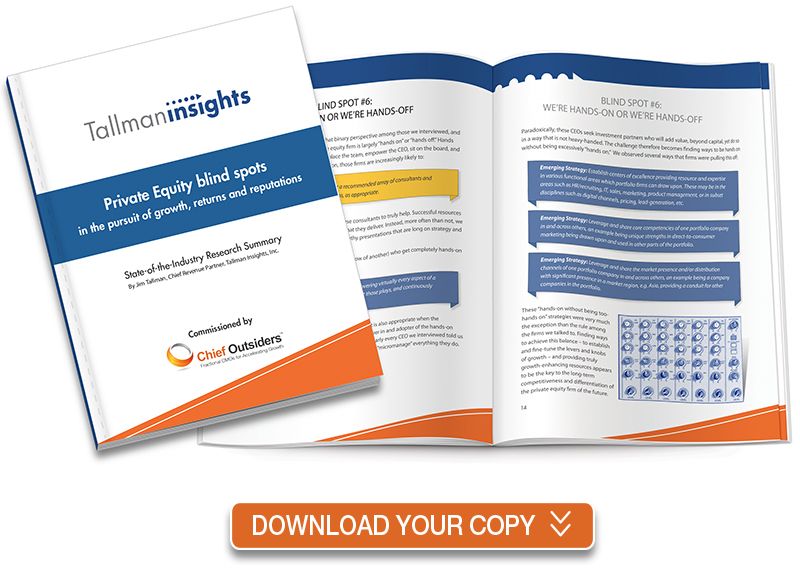
Portfolio Company Marketing at the Speed of Now
Several trends in the private equity landscape demand GPs focus on accelerated growth initiatives to drive returns, which requires an infusion of marketing expertise, says Karen Hayward of Chief Outsiders.
Private equity’s long boom is proving to be mixed blessing. According to Prequin, deal making through the third quarter of 2019 is matching that of 2018. GPs are still raising record levels of capital, meaning the competition for deals, reflected in the high price of assets, won’t be subsiding anytime soon. More concerning is that the pace of exits has been slowing, with 2019’s exits looking to fall short of 2018’s numbers, a situation that has yet to dampen LPs enthusiasm for the asset class… yet.
So GPs will have to work all the harder to meet those expectations, and that can be reduced to a single word: “growth.” Growth at a scale and speed that will produce returns on today’s high prices. One GP admitted that they are planning to exit at lower multiples than they are paying, with the idea that sufficient growth will still get their fund the IRR their investors expect. The reason for this is that bolt-ons come in at lower multiples and as a result, the weighted average buy-in multiple will be lower than that of the original platform.
But that kind of growth requires much more than fixing the balance sheet and adding a few extra sales staff. This takes a serious upgrade in the Company’s marketing effort. “A lot of GPs understand that the right marketing strategy can launch and accelerate a company’s growth,” says Karen Hayward, a CMO with Chief Outsiders. “So we’re seeing a lot of PE firms conducting marketing due diligence pre- letter of intent.” This allows them to understand what it’ll take to improve a Company’s marketing.
The issue is that often even if they comprehend the state of a marketing program, it can be tricky to know what to do next. “A lot of these portfolio companies are industrial plays that really never had to use marketing to drive business, so in some ways, it’s like starting from scratch,” says Hayward. “The depth and breadth of the due diligence, both pre- and post-LOI, in a shorter period of time, means a management team has been highly distracted for months, so time is of the essence.”
Complicating this is the fact that there’s not a magic hire that can solve all their marketing needs. “There’s no such thing as a full stack CMO anymore,” says Hayward. “There’s no one who can show up and be everything the Company needs. Let’s say a portfolio company needs a brand-new digital strategy, but that’s something that can’t be easily outsourced to an agency; that needs to be brought in-house. Within a year, to a year and half, we have to bring multiple kinds of marketing expertise to an account.”
Hayward is able to do that as a fractional CMO, as they can leverage Chief Outsiders’ full bench of marketing talent, either by close collaboration on an account, or by having a new CMO step into the Company, when its needs change. She cites one example with a gun locker storage company. “They were focused on fixing their brand and brand advertising, so we brought in a CMO that helped save money in their media spend and optimized things, but soon realized there was a massive e-commerce opportunity,” says Hayward. Instead of tapping some outside agency for an expensive engagement, that CMO simply stepped down and let a CMO with real e-commerce chops take over the reins. It’s safe to say that a traditional CMO wouldn’t be so quick to step down in the interest of the Company.
The other facet of GPs’ hunger for accelerated growth is the boom in bolt-on strategies. “With the limited time horizons of private equity, GPs are relying on platform build-up plays more than ever,” says Hayward. “But acquiring competitors or adjacent businesses requires an understanding of how to marry the marketing efforts of those various units that are now under the same roof.”
Hayward isn’t merely talking about combining marketing initiatives quickly, but the fact that marketing for platform companies is its own skill. “The expertise in brand rationalization, positioning, and communications with employees, clients, and so on, takes time to develop, and most GPs don’t have the luxury of learning as they go along.” It’s a skill set that Chief Outsiders has made a priority to develop.
“We’re able to put a plan together and review it with five or six other internal CMOs before even sharing it with a client,” says Hayward. “Let’s say I’m working on the diligence plan and discover a pricing problem, I’ll be able to tap a colleague with that area of expertise and figure out what to do next.”
All of this allows the private equity firm to hit the ground running with a plan, rather than wasting six to eight months building up a marketing team from zero. If this seems like a breakneck pace, it is, but with the high price of assets and LPs in no mood to lower their expectations, the GPs have little choice but to step on the gas. But that also requires having the right engine for growth, and that means marketing can’t be ignored.
“The reality is that marketing owns a much bigger part of the sales function than ever before,” says Hayward. “Today’s B2B buyers are doing so much purchase diligence online, they’re 60 to 80% of the way to a decision before ever contacting a member of the sales staff.” In this way, if the future of private equity is a growth question, then marketing might increasingly be the answer.
Download this insightful study which identifies seven blind spots evident among private equity firms seeking portfolio company growth.
Topics: Fractional CMO, Private Equity
Oct 28, 2019 4:50:31 PM.png?width=1500&height=398&name=CO_Corporate%20Logo%202021_4C_HOR_FNL-1%20(1).png)


